tow SATURN RELAY 2007 Owner's Manual
[x] Cancel search | Manufacturer: SATURN, Model Year: 2007, Model line: RELAY, Model: SATURN RELAY 2007Pages: 570, PDF Size: 3.41 MB
Page 144 of 570

REVERSE (R):Use this gear to back up.
Notice:Shifting to REVERSE (R) while your
vehicle is moving forward could damage
the transaxle. The repairs would not be
covered by your warranty. Shift to
REVERSE (R) only after your vehicle is
stopped.
To rock your vehicle back and forth to get out
of snow, ice or sand without damaging your
transaxle, seeIf Your Vehicle is Stuck in Sand,
Mud, Ice, or Snow on page 390.
NEUTRAL (N):In this position, your engine does
not connect with the wheels. To restart when
you are already moving, use NEUTRAL (N) only.
Also, use NEUTRAL (N) when your vehicle is
being towed.
{CAUTION:
Shifting into a drive gear while your
engine is running at high speed is
dangerous. Unless your foot is �rmly on
the brake pedal, your vehicle could move
very rapidly. You could lose control and
hit people or objects. Do not shift into a
drive gear while your engine is running at
high speed.
Notice:Shifting out of PARK (P) or
NEUTRAL (N) while the engine is running at
high speed may damage the transaxle.
The repairs would not be covered by your
warranty. Be sure the engine is not running at
high speeds when shifting your vehicle.
144
ProCarManuals.com
Page 145 of 570
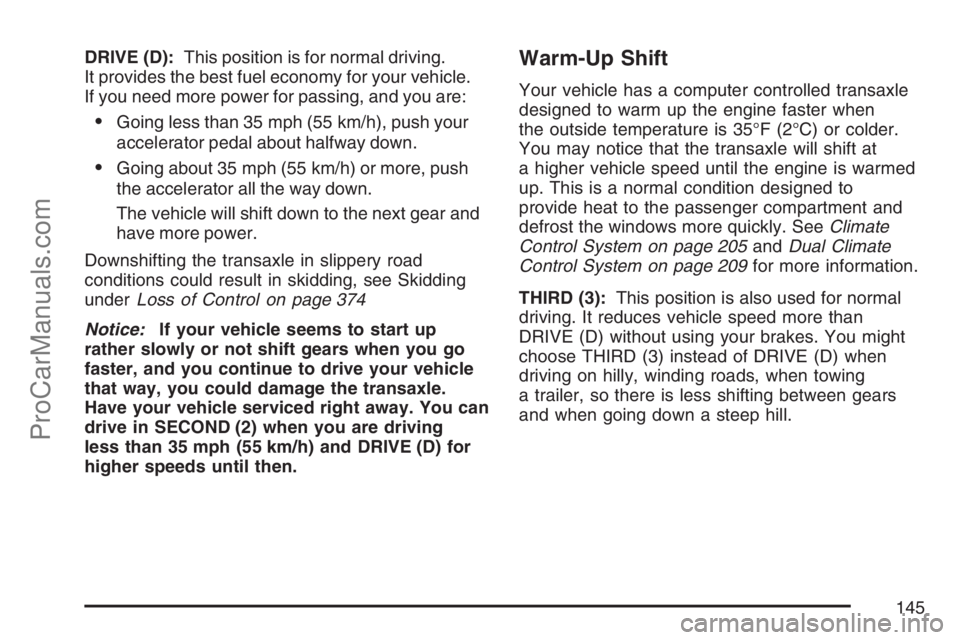
DRIVE (D):This position is for normal driving.
It provides the best fuel economy for your vehicle.
If you need more power for passing, and you are:
Going less than 35 mph (55 km/h), push your
accelerator pedal about halfway down.
Going about 35 mph (55 km/h) or more, push
the accelerator all the way down.
The vehicle will shift down to the next gear and
have more power.
Downshifting the transaxle in slippery road
conditions could result in skidding, see Skidding
underLoss of Control on page 374
Notice:If your vehicle seems to start up
rather slowly or not shift gears when you go
faster, and you continue to drive your vehicle
that way, you could damage the transaxle.
Have your vehicle serviced right away. You can
drive in SECOND (2) when you are driving
less than 35 mph (55 km/h) and DRIVE (D) for
higher speeds until then.
Warm-Up Shift
Your vehicle has a computer controlled transaxle
designed to warm up the engine faster when
the outside temperature is 35°F (2°C) or colder.
You may notice that the transaxle will shift at
a higher vehicle speed until the engine is warmed
up. This is a normal condition designed to
provide heat to the passenger compartment and
defrost the windows more quickly. SeeClimate
Control System on page 205andDual Climate
Control System on page 209for more information.
THIRD (3):This position is also used for normal
driving. It reduces vehicle speed more than
DRIVE (D) without using your brakes. You might
choose THIRD (3) instead of DRIVE (D) when
driving on hilly, winding roads, when towing
a trailer, so there is less shifting between gears
and when going down a steep hill.
145
ProCarManuals.com
Page 147 of 570
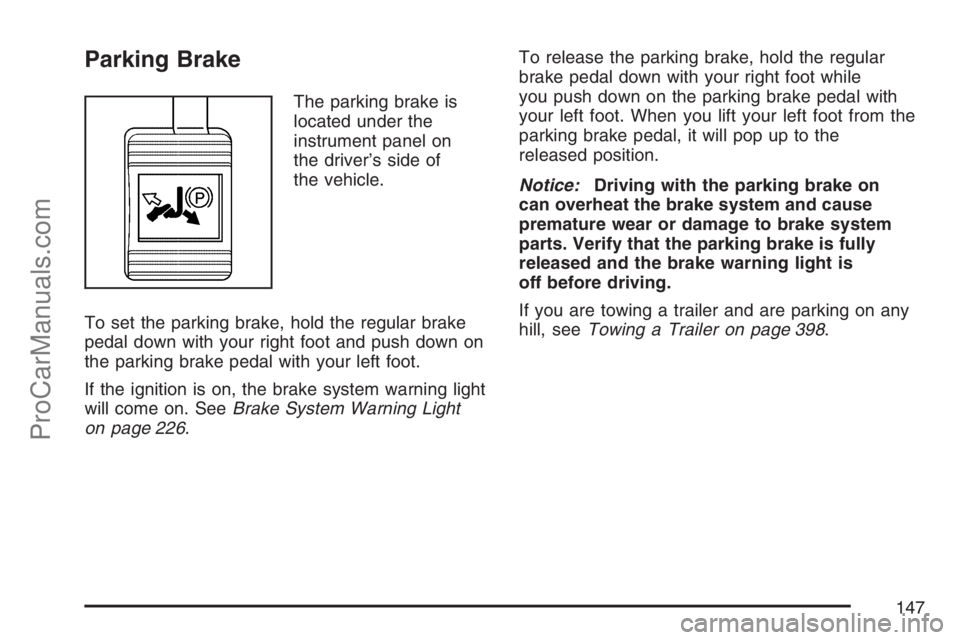
Parking Brake
The parking brake is
located under the
instrument panel on
the driver’s side of
the vehicle.
To set the parking brake, hold the regular brake
pedal down with your right foot and push down on
the parking brake pedal with your left foot.
If the ignition is on, the brake system warning light
will come on. SeeBrake System Warning Light
on page 226.To release the parking brake, hold the regular
brake pedal down with your right foot while
you push down on the parking brake pedal with
your left foot. When you lift your left foot from the
parking brake pedal, it will pop up to the
released position.
Notice:Driving with the parking brake on
can overheat the brake system and cause
premature wear or damage to brake system
parts. Verify that the parking brake is fully
released and the brake warning light is
off before driving.
If you are towing a trailer and are parking on any
hill, seeTowing a Trailer on page 398.
147
ProCarManuals.com
Page 148 of 570

Shifting Into Park (P)
{CAUTION:
It can be dangerous to get out of your
vehicle if the shift lever is not fully in
PARK (P) with the parking brake �rmly set.
Your vehicle can roll. If you have left the
engine running, the vehicle can move
suddenly. You or others could be injured.
To be sure your vehicle will not move, even
when you are on fairly level ground, use
the steps that follow. If you are pulling a
trailer, seeTowing a Trailer on page 398.
1. Hold the brake pedal down with your right foot
and set the parking brake with your left foot.
2. Move the shift lever into PARK (P) by pulling
the shift lever toward you and moving it up as
far as it will go.
3. Turn the ignition key to LOCK.
4. Remove the key and take it with you. If you
can leave your vehicle with the ignition key in
your hand, your vehicle is in PARK (P).
Leaving Your Vehicle With the
Engine Running
{CAUTION:
It can be dangerous to leave your vehicle
with the engine running. Your vehicle
could move suddenly if the shift lever is
not fully in PARK (P) with the parking
brake �rmly set. And, if you leave the
vehicle with the engine running, it could
overheat and even catch �re. You or
others could be injured. Do not leave your
vehicle with the engine running.
If you have to leave your vehicle with the engine
running, be sure your vehicle is in PARK (P)
and the parking brake is �rmly set before
you leave it. After you move the shift lever into
PARK (P), hold the regular brake pedal down.
Then, see if you can move the shift lever away
from PARK (P) without �rst pulling it toward you.
If you can, it means that the shift lever was
not fully locked into PARK (P).
148
ProCarManuals.com
Page 152 of 570
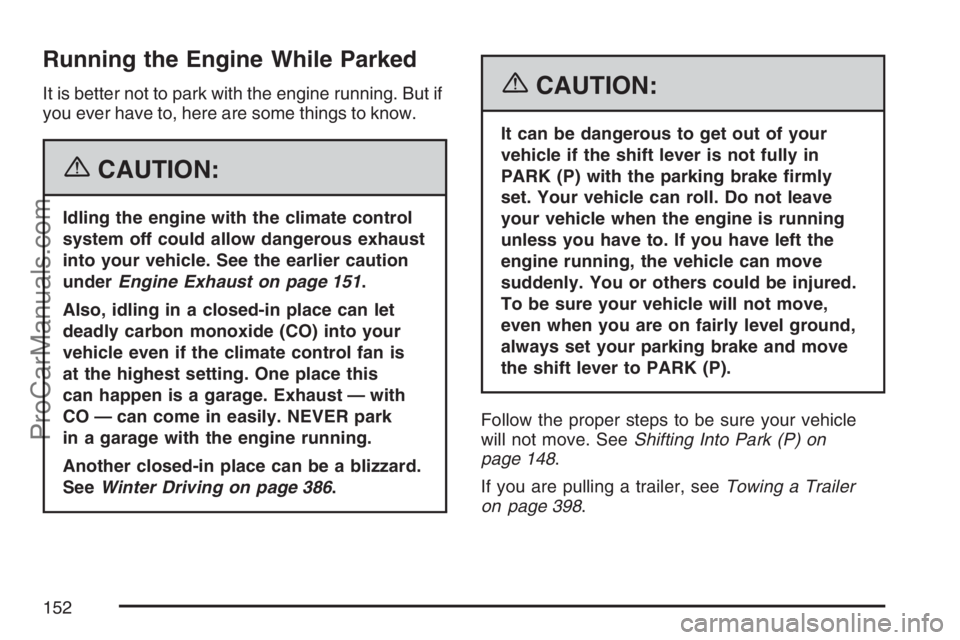
Running the Engine While Parked
It is better not to park with the engine running. But if
you ever have to, here are some things to know.
{CAUTION:
Idling the engine with the climate control
system off could allow dangerous exhaust
into your vehicle. See the earlier caution
underEngine Exhaust on page 151.
Also, idling in a closed-in place can let
deadly carbon monoxide (CO) into your
vehicle even if the climate control fan is
at the highest setting. One place this
can happen is a garage. Exhaust — with
CO — can come in easily. NEVER park
in a garage with the engine running.
Another closed-in place can be a blizzard.
SeeWinter Driving on page 386.
{CAUTION:
It can be dangerous to get out of your
vehicle if the shift lever is not fully in
PARK (P) with the parking brake �rmly
set. Your vehicle can roll. Do not leave
your vehicle when the engine is running
unless you have to. If you have left the
engine running, the vehicle can move
suddenly. You or others could be injured.
To be sure your vehicle will not move,
even when you are on fairly level ground,
always set your parking brake and move
the shift lever to PARK (P).
Follow the proper steps to be sure your vehicle
will not move. SeeShifting Into Park (P) on
page 148.
If you are pulling a trailer, seeTowing a Trailer
on page 398.
152
ProCarManuals.com
Page 174 of 570
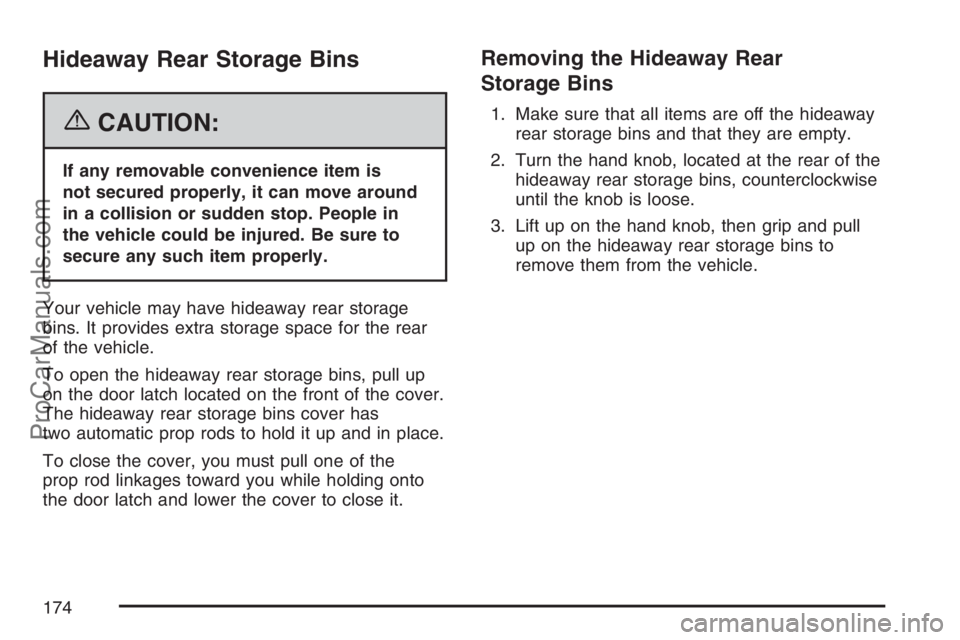
Hideaway Rear Storage Bins
{CAUTION:
If any removable convenience item is
not secured properly, it can move around
in a collision or sudden stop. People in
the vehicle could be injured. Be sure to
secure any such item properly.
Your vehicle may have hideaway rear storage
bins. It provides extra storage space for the rear
of the vehicle.
To open the hideaway rear storage bins, pull up
on the door latch located on the front of the cover.
The hideaway rear storage bins cover has
two automatic prop rods to hold it up and in place.
To close the cover, you must pull one of the
prop rod linkages toward you while holding onto
the door latch and lower the cover to close it.
Removing the Hideaway Rear
Storage Bins
1. Make sure that all items are off the hideaway
rear storage bins and that they are empty.
2. Turn the hand knob, located at the rear of the
hideaway rear storage bins, counterclockwise
until the knob is loose.
3. Lift up on the hand knob, then grip and pull
up on the hideaway rear storage bins to
remove them from the vehicle.
174
ProCarManuals.com
Page 184 of 570

LWindshield Washer. SeeWindshield
Washer on page 186.
ZRear Window Wiper. SeeWindshield
Washer on page 186.
=Rear Window Washer. SeeWindshield
Washer on page 186.
For information on the headlamps, seeExterior
Lamps on page 192.
Turn and Lane-Change Signals
The turn signal has two upward (for right) and
two downward (for left) positions. These positions
allow you to signal a turn or a lane change.
To signal a turn, move the lever all the way up or
down. When the turn is �nished, the lever will
return automatically.
An arrow on the
instrument panel cluster
will �ash in the direction
of the turn or lane
change.To signal a lane change, just raise or lower the
lever until the arrow starts to �ash. Hold it
there until you complete your lane change. The
lever will return by itself when you release it.
As you signal a turn or a lane change, if the arrow
�ashes faster than normal, a signal bulb may
be burned out and other drivers will not see your
turn signal.
If a bulb is burned out, replace it to help avoid an
accident. If the arrows do not go on at all when
you signal a turn, check for burned-out bulbs and
check the fuse. SeeBulb Replacement on
page 455andFuses and Circuit Breakers on
page 512.
If you have a trailer towing option with added
wiring for the trailer lamps, the signal indicator will
�ash at a normal rate even if a turn signal bulb
is burned out. Check the front and rear turn signal
lamps regularly to make sure they are working.
184
ProCarManuals.com
Page 185 of 570

Turn Signal On Chime
If either turn signal is left on for more than 3/4 mile
(1.2 km), a chime will sound to let the driver
know to turn it off. If you need to leave the signal
on for more than 3/4 mile (1.2 km), turn off the
signal and then turn it back on.
Headlamp High/Low-Beam Changer
To change the headlamps from low beam to
high beam, push the turn signal/multifunction lever
away from you.
When the high beams
are on, this light will
appear on the
instrument panel cluster.
To change the headlamps from high beam to low
beam, pull the turn signal/multifunction lever
toward you.
Flash-to-Pass
When the headlamps are off, pull the lever toward
you to momentarily turn on the high beams.
This will signal that you are going to pass. When
you release the lever, they will turn off.
Windshield Wipers
You control the windshield wipers by turning the
band with the wiper symbol on it.
8(Mist):For a single wiping cycle, turn the
band to mist. Hold it there until the wipers start.
Then let go. The wipers will stop after one wipe.
If you want more wipes, hold the band on mist
longer.
9(Off):To stop the wipers, move the band to off.
N(Delay):You can set the wiper speed for a
long or short delay between wipes. This can
be very useful in light rain or snow. Turn the band
to choose the delay time. The closer to the top
of the lever, the shorter the delay.
185
ProCarManuals.com
Page 190 of 570
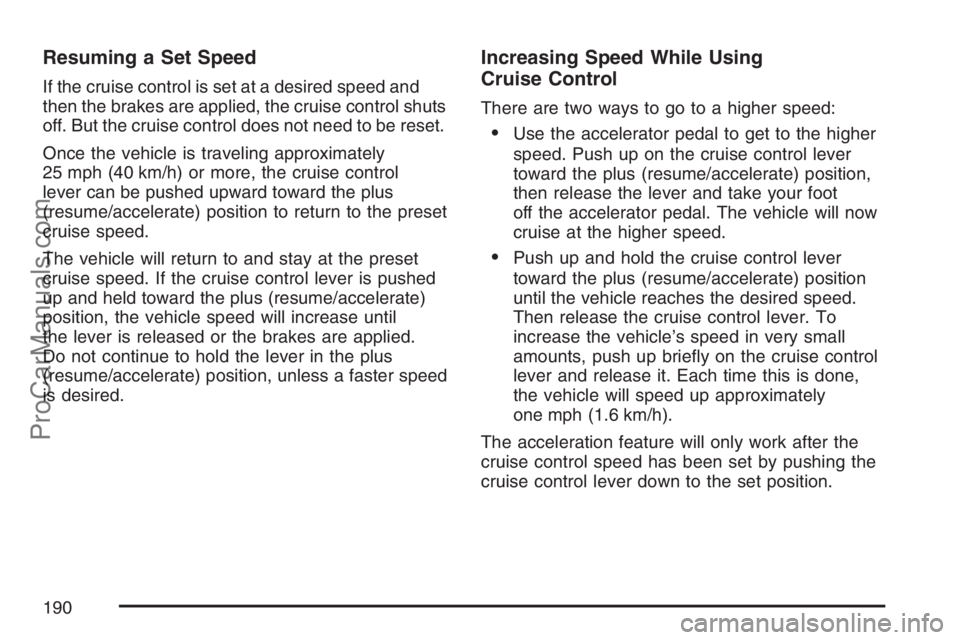
Resuming a Set Speed
If the cruise control is set at a desired speed and
then the brakes are applied, the cruise control shuts
off. But the cruise control does not need to be reset.
Once the vehicle is traveling approximately
25 mph (40 km/h) or more, the cruise control
lever can be pushed upward toward the plus
(resume/accelerate) position to return to the preset
cruise speed.
The vehicle will return to and stay at the preset
cruise speed. If the cruise control lever is pushed
up and held toward the plus (resume/accelerate)
position, the vehicle speed will increase until
the lever is released or the brakes are applied.
Do not continue to hold the lever in the plus
(resume/accelerate) position, unless a faster speed
is desired.
Increasing Speed While Using
Cruise Control
There are two ways to go to a higher speed:
Use the accelerator pedal to get to the higher
speed. Push up on the cruise control lever
toward the plus (resume/accelerate) position,
then release the lever and take your foot
off the accelerator pedal. The vehicle will now
cruise at the higher speed.
Push up and hold the cruise control lever
toward the plus (resume/accelerate) position
until the vehicle reaches the desired speed.
Then release the cruise control lever. To
increase the vehicle’s speed in very small
amounts, push up brie�y on the cruise control
lever and release it. Each time this is done,
the vehicle will speed up approximately
one mph (1.6 km/h).
The acceleration feature will only work after the
cruise control speed has been set by pushing the
cruise control lever down to the set position.
190
ProCarManuals.com
Page 191 of 570
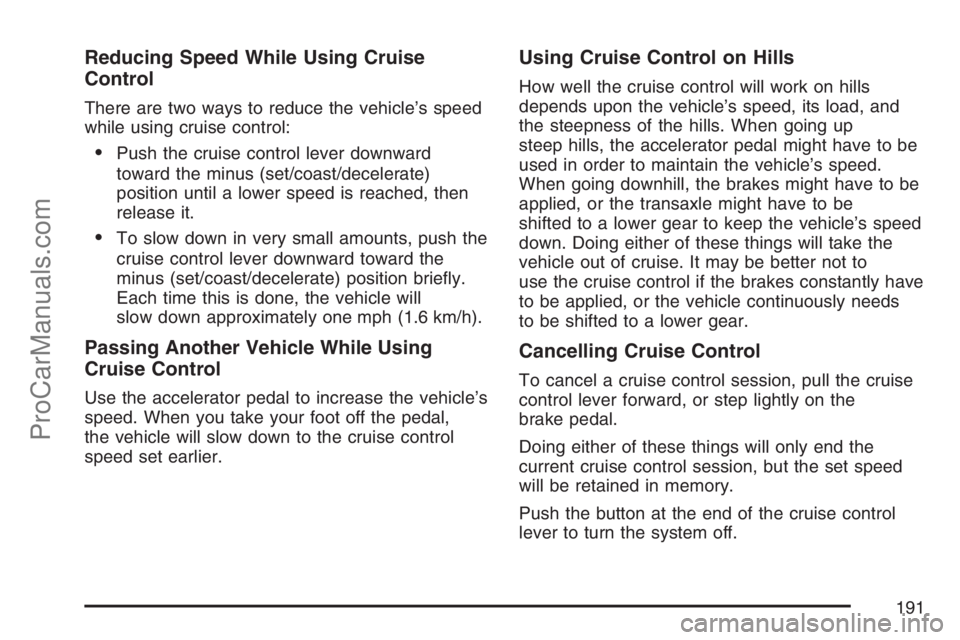
Reducing Speed While Using Cruise
Control
There are two ways to reduce the vehicle’s speed
while using cruise control:
Push the cruise control lever downward
toward the minus (set/coast/decelerate)
position until a lower speed is reached, then
release it.
To slow down in very small amounts, push the
cruise control lever downward toward the
minus (set/coast/decelerate) position brie�y.
Each time this is done, the vehicle will
slow down approximately one mph (1.6 km/h).
Passing Another Vehicle While Using
Cruise Control
Use the accelerator pedal to increase the vehicle’s
speed. When you take your foot off the pedal,
the vehicle will slow down to the cruise control
speed set earlier.
Using Cruise Control on Hills
How well the cruise control will work on hills
depends upon the vehicle’s speed, its load, and
the steepness of the hills. When going up
steep hills, the accelerator pedal might have to be
used in order to maintain the vehicle’s speed.
When going downhill, the brakes might have to be
applied, or the transaxle might have to be
shifted to a lower gear to keep the vehicle’s speed
down. Doing either of these things will take the
vehicle out of cruise. It may be better not to
use the cruise control if the brakes constantly have
to be applied, or the vehicle continuously needs
to be shifted to a lower gear.
Cancelling Cruise Control
To cancel a cruise control session, pull the cruise
control lever forward, or step lightly on the
brake pedal.
Doing either of these things will only end the
current cruise control session, but the set speed
will be retained in memory.
Push the button at the end of the cruise control
lever to turn the system off.
191
ProCarManuals.com